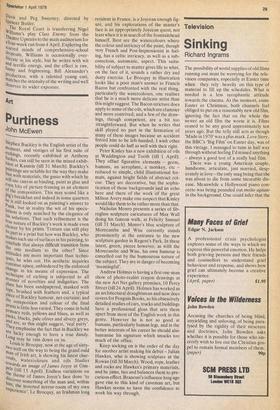Art
Puniness John mcEwen
Stephen Buckley is the English artist of the moment, and vestiges of his first suite of !tchings, recently exhibited at Anthony ?t.okes, can still be seen in the mixed exhibition at Kasmin (till 31 March). Buckley's Paintings are notable for the way they make free with materials, the gusto with which he Will use canvas as binding, paint as glue and even bits of picture-framing as an element of the composition. This may sound like a Pilg's breakfast and indeed in some quarters is still looked on as painting's answer to Punk, but in reality the wit of his speculations is only matched by the elegance of his solutions. That such refinement is the true nature of Buckley's work is made even clearer by his prints. Texture can still play Its part in a print but how was Buckley, who makes such use of surfaces in his painting, to conclude that always difficult transition from the one medium to the other? Since attitudes are more important than techniques, he wins out. His aesthetic inquiries continue apace, unhindered by the enforced change in his means of expression. The technique of etching is subjected to all manner of novelties and indignities. The Plate has been sandpapered, masked with tape, brushed with feathers and, a typical Piece of Buckley humour, net-curtains; and the composition and colour of the final Prints is little less varied. They come in bold Primary reds, yellows and blues, as well as Pinks, blacks, pale olives and silvery greys, They are, as this might suggest, 'real purty'. Ihey emphasise the fact that in Buckley we Tare lucky enough to have a true dandy. tmag may he rain down on .us. Louis le Brocquy, now at the age of sixtytwo well on the way to being the grand ould
man of Irish art, is showing his latest char
coals, watercolours and oils Studies 'wards an image of James Joyce at Gim-.
Pels (till 15 April). Endless variations on the theme of James Joyce's face done 'to clr!scover something of the man and, within
`Ian, the inverted mirror-room of my own exPerience'. Le Brocquy, an Irishman long
resident in France, is a Joycean enough figure, and his explorations of the master's face is an appropriately Joycean quest, not least when it is in search of the fountainhead himself. Best are the watercolours where the colour and intricacy of the paint, though very French and Post-Impressionist in feeling, has a celtic intricacy, as well as a subconscious, automatic, aspect. This suitability of subject to matter gives life to what, on the face of it, sounds a rather dry and dusty exercise. Le Brocquy in illustration looks like a poor man's answer to Francis Bacon but confronted with the real thing, particularly the watercolours, one realises that he is a much more delicate artist than this might suggest. The Bacon stricture does apply to some of the oils, which are clumsier and more contrived; and a few of the drawings, though competent, are a bit too straightforward. But when he writes that skill played no part in the formation of many of these images because an accident forced him to be left-handed, I wish other people could do half as well with their right.
Peter Kinky has a new exhibition of oils at Waddington and Tooth (till 1 April). They offset figurative elements — geese, humans, an aeroplane, a monkey, etc — reduced to simple, child illustrational formats, against bright fields of abstract colour. They are decorative, but the sophistication of those backgrounds and an echo here and there of the work of the great Milton Avery make one suspect that Kinley would like them to be rather more than that.
Nicholas Monro presents a series of fibreglass sculpture caricatures of Max Wall doing his famous walk, at Felicity Samuel (till 31 March). Monro's blue sculpture of Morecambe and Wise currently stands prominently at the entrance to the new sculpture garden in Regent's Park. In these latest, green, pieces however, as with the Morecambe and Wise, his own humour is cancelled out by the humourous nature of the subject. They are in danger of becoming 'meaningful'.
Andrew Holmes is having a first one-man show of photo-realist crayon drawings at the new Art Net gallery premises, 10 Percy Street (till 24 April). Holmes has worked as an architectural draughtsman and now does covers for Penguin Books, so his obsessively detailed studies of cars, trucks and buildings have a professional gloss that sets them apart from most of the English work in this genre. However he is not so good at humans, particularly human legs, and in the better interests of his career he should also humanise his signature which smacks too much of the office.
Keep socking on is the order of the day for another artist making his debut —Julian Hawkes, who is showing sculpture at the Rowan (till 30 March). Wood, rope, leather and rocks are Hawkes's primary materials, and he jams, ties and balances them to precarious effect. Brancusi's influence long ago gave rise to this kind of caveman art, but Hawkes seems to have the confidence to work his way through.


































 Previous page
Previous page